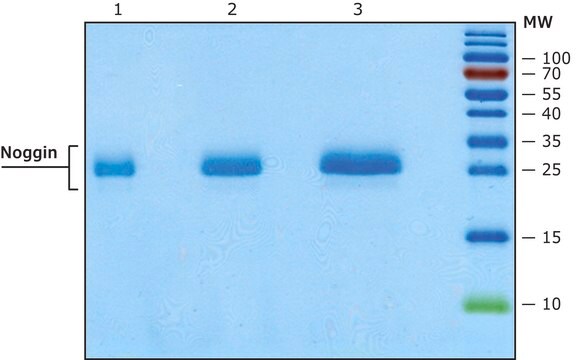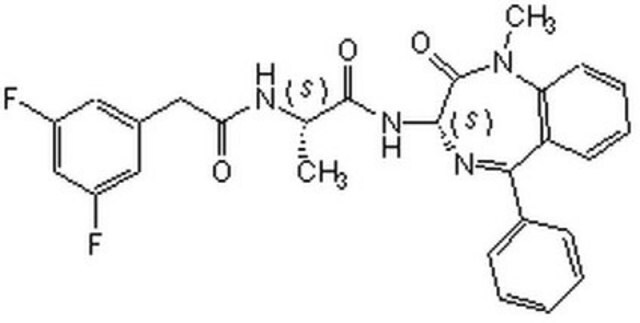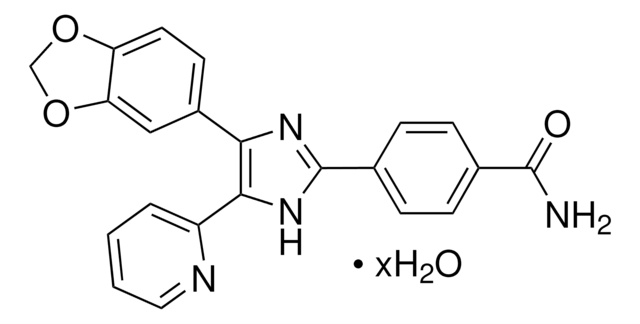SRP4675
Noggin human
recombinant, expressed in E. coli, ≥95% (SDS-PAGE), ≥95% (HPLC)
Synonym(e):
NOG, SYM1, SYNS1
Anmeldenzur Ansicht organisationsspezifischer und vertraglich vereinbarter Preise
Alle Fotos(1)
About This Item
Empfohlene Produkte
Allgemeine Beschreibung
Noggin (NOG) belongs to a group of diffusible proteins which bind to ligands of the TGF (transforming growth factor)-β family and regulate their activity by inhibiting their access to signaling receptors. The protein is secreted and exists as a disulfide-linked homodimer. The gene NOG is mapped to human chromosome 17q22. Recombinant human Noggin is a 23.1kDa non-disulfide-linked homodimer consisting of a total of 206 amino acid residues.
Anwendung
Noggin (NOG) human has been used as a BMP antagonist.
Biochem./physiol. Wirkung
Noggin (NOG) was originally identified as a BMP-4 (bone morphogenetic protein 4) antagonist whose action is critical for proper formation of the head and other dorsal structures. Consequently, Noggin has been shown to modulate the activities of other BMPs including BMP-2,-7,-13, and -14. Transgenic mice over-expressing Noggin in mature osteoblasts display impaired osteoblastic differentiation, reduced bone formation, and severe osteoporosis. In mice, loss of noggin causes malformations in skeletal system. In mouse noggin is associated with tissue patterning by participating in cell differentiation, cell proliferation and apoptosis in the developing embryo. Mutations in the gene is associated with several disorders, including proximal symphalangism, multiple synostoses, tarsal/carpal coalition syndrome and Teunissen–Cremers syndrome. It is a gene which is also linked with conductive hearing loss. Polymorphism in the gene might be associated with reduced risk of nonsyndromic cleft lip with or without cleft palate (NSCLP).
Physikalische Form
Lyophilized without any additives.
Rekonstituierung
Centrifuge the vial prior to opening. Avoid freeze-thaw cycles.
Reconstitute in water to a concentration of 0.1 to 1.0 mg/mL. Note: Due to solubility reasons the protein should be kept at low pH. This solution can then be diluted into other aqueous buffers.
Lagerklassenschlüssel
11 - Combustible Solids
WGK
WGK 3
Flammpunkt (°F)
Not applicable
Flammpunkt (°C)
Not applicable
Analysenzertifikate (COA)
Suchen Sie nach Analysenzertifikate (COA), indem Sie die Lot-/Chargennummer des Produkts eingeben. Lot- und Chargennummern sind auf dem Produktetikett hinter den Wörtern ‘Lot’ oder ‘Batch’ (Lot oder Charge) zu finden.
Besitzen Sie dieses Produkt bereits?
In der Dokumentenbibliothek finden Sie die Dokumentation zu den Produkten, die Sie kürzlich erworben haben.
Kunden haben sich ebenfalls angesehen
Association between NOGGIN and SPRY2 polymorphisms and nonsyndromic cleft lip with or without cleft palate.
Song T
American Journal of Medical Genetics. Part A, 167A, 137-141 (2015)
Nonsyndromic cleft lip with or without cleft palate: Increased burden of rare variants within Gremlin-1, a component of the bone morphogenetic protein 4 pathway.
Al Chawa T
Birth Defects Research Part A: Clinical and Molecular Teratology, 100, 493-498 (2014)
Impaired osteoblastic differentiation, reduced bone formation, and severe osteoporosis in noggin-overexpressing mice.
Wu XB
The Journal of Clinical Investigation, 115, 1390-1390 (2005)
The WNT inhibitor Dickkopf 1 and bone morphogenetic protein 4 rescue adipogenesis in hypertrophic obesity in humans.
Gustafson B and Smith U
Diabetes, 61, 1217-1224 (2012)
The expression patterns of gremlin 1 and noggin in normal adult and tumor tissues.
Laurila R
International Journal of Clinical and Experimental Pathology, 6, 1400-1408 (2013)
Artikel
Organoid culture products to generate tissue and stem cell derived 3D brain, intestinal, gut, lung and cancer tumor organoid models.
Unser Team von Wissenschaftlern verfügt über Erfahrung in allen Forschungsbereichen einschließlich Life Science, Materialwissenschaften, chemischer Synthese, Chromatographie, Analytik und vielen mehr..
Setzen Sie sich mit dem technischen Dienst in Verbindung.






![[Leu15]-Gastrin I Human ≥95% (HPLC)](/deepweb/assets/sigmaaldrich/product/structures/153/342/d4cb3dd7-13f1-46cf-8d1f-3907a5de7a83/640/d4cb3dd7-13f1-46cf-8d1f-3907a5de7a83.png)




